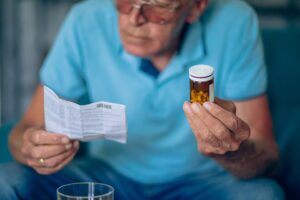Medical Review by Jennie Stanford, MD, FAAFP, DABOM
Summary
- Stendra® (avanafil) is an ED medication, but drinking alcohol with it can pose risks by further lowering blood pressure.
- Consuming more than three drinks while taking Stendra® can increase the risk of a drop in blood pressure, especially after sitting or lying down.
- A sudden drop in blood pressure can lead to dizziness, headaches, and falls or loss of consciousness in some cases. It can also cause urgent medical issues if blood flow to vital organs is affected.
- To reduce the risks of drinking alcohol while using Stendra®, you can limit the number of drinks you have, wait a few hours between drinking and taking the medication, or avoid alcohol entirely.
- Check-in frequently with your healthcare provider if you take Stendra®, especially if you consume alcohol. They can provide personalized guidance based on your health history and lifestyle.
Stendra® is a popular ED medication—but drinking too much alcohol while you take it has risks
Stendra®—a branded form of the medication avanafil—is commonly prescribed to help men manage erectile dysfunction (ED). However, like all medications, Stendra® can interact with other substances. If you’re considering taking this drug to help treat ED, it’s normal to wonder whether it could impact your ability to drink alcohol.
So will drinking alcohol increase your risk of side effects from Stendra® or make it less effective? The answer likely depends on how much alcohol you drink while using this medication. Below, we explain how taking alcohol and Stendra® together can affect your body, so that you can make more informed decisions with your healthcare provider about whether this medication is right for you.
Quick facts about how Stendra® works
Stendra® and avanafil belong to the class of drugs known as PDE5 inhibitors —which also include the drugs Viagra® (sildenafil) and Cialis® (tadalafil). All of these medications work in a similar way: they cause the blood vessels that supply the muscles in your penis to dilate, which helps improve blood flow to that area when you’re aroused so that it’s easier to get and maintain an erection.
This process of expanding your blood vessels is called vasodilation—as the vessels get larger in diameter, it’s easier for blood to flow through them. This causes your blood pressure to go down.
Risks of combining alcohol & Stendra®
Alcohol is a vasodilator as well, so drinking it also lowers your blood pressure (although moderate to heavy drinking will eventually cause your blood pressure to go up, because alcohol damages your vascular system over time).
But that means drinking too much while you’re taking Stendra® or another medication that works in the same way can cause your blood pressure to drop below healthy levels in the short term—and this can come with several unwanted effects and risks.
According to the patient information for Stendra®, having more than three standard alcoholic drinks when taking this medication can lead to the following issues:
- Increased heart rate
- Decrease in standing blood pressure
- Dizziness
- Headache
These effects are the result of a condition called orthostatic hypotension—a sudden drop in blood pressure (in this case caused by mixing Stendra® with alcohol) when getting up after sitting or lying down. Because it occurs quickly and does not always come with early warning signs, orthostatic hypotension also carries the risk of falling down or passing out—which can make it dangerous.
In some cases, low blood pressure can also prevent enough blood from flowing to your vital organs. This can require immediate professional medical assistance, so contact your healthcare provider if you start to feel unwell while drinking and taking Stendra®, or visit your nearest emergency room if they are not available.
Safer practices for Stendra® if you drink alcohol
If you’re taking Stendra®, carefully monitoring and controlling your alcohol intake is the easiest way to reduce the chance of unwanted interactions and keep you safer while using your medication. Here are a few recommendations:
Limit your alcohol consumption
The patient information for Stendra® suggests avoiding more than three standard drinks during periods when you are taking the medication. Lower levels of alcohol are less likely to make your blood pressure drop dangerously while taking Stendra®, although every individual is different and reactions can vary.
Alcohol use is also linked to increased rates of ED in men—so drinking less when taking Stendra® can remove a potential obstacle in the way of your medication doing its job properly.
Stay hydrated
There’s no evidence showing that drinking water makes alcohol less potent. However, it can offset some of the dehydrating effects of alcohol, like headaches and dizziness—which are also possible side effects of low blood pressure from mixing Stendra® and alcohol.
Wait after drinking
To minimize risk, it may help to wait at least a few hours between consuming any alcohol and taking Stendra®. This allows some of the alcohol to be processed by the body over time.
Avoid drinking on days when you take Stendra®
The easiest way to make sure Stendra® won’t interact negatively with alcohol is to avoid mixing them entirely. This is particularly important if you are sensitive to alcohol or experience low blood pressure episodes.
Consulting a healthcare provider
As with any prescription medication, consulting a healthcare provider before combining Stendra® and alcohol is crucial. Your healthcare provider can give you personalized guidance on how to use Stendra® safely, depending on your health history, medications, and lifestyle.
Certain people may have a higher risk of side effects from Stendra® than others. Your healthcare provider could suggest that you may benefit from a lower dose or a different approach to treating ED that comes with less risk.
Find expert support to help you use Stendra® with confidence
Stendra® offers an effective solution for ED—but like all medications, you need to use it responsibly for best results. While one or two alcoholic drinks on Stendra® may not cause serious problems for most people, combining these two substances can make certain risks and side effects more likely.
By limiting alcohol consumption, waiting between drinks and doses, and consulting with your healthcare provider, you can take Stendra® with greater confidence and lower your risk of unwanted effects.
* Stendra is not currently available through Lemonaid Health.
Stendra® is a registered trademark of Vivus, Inc. Viagra® is a registered trademark of Viatris Specialty LLC, a Viatris Company. Cialis® is a registered trademark of Lilly ICOS LLC.












